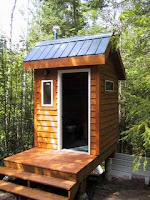 I went grocery shopping yesterday and did a little fridge clean out in preparation for February's Food Waste Reduction Challenge. No I wasn't cheating to get rid of food I know I wasn't going to eat - just composting food that was past its prime and inedible. You know, the real scary stuff.
I went grocery shopping yesterday and did a little fridge clean out in preparation for February's Food Waste Reduction Challenge. No I wasn't cheating to get rid of food I know I wasn't going to eat - just composting food that was past its prime and inedible. You know, the real scary stuff.But, even though I had a few days before I embarked on really reducing the food waste I'm generating, I couldn't help but start last night. That meant that the few teaspoons of lemon juice leftover from my husband's homemade blackberry pie (with blackberries we froze last summer and local leaf lard for the crust) got saved to use for the million avocados that are all ripening at once. Yes, we have a load of avocados from my brother's backyard.
That also meant that the leftover dough from the lattice crust from the pie ended up getting baked with sugar and cinnamon for last night's dessert. I don't have much control over the food waste generated from my kids, it just means that I have to be really diligent about giving them food that I know they will eat in portions they will finish. I'm not talking about being short-order cook for them, but meal planning with things I know they will eat.
One thing that has been brought up in the comments of people pledging to do the challenge so far is the notion that food scraps given to the chickens, goats, pigs, etc. don't count. Well, if you are looking at it from a cost standpoint, if that's what you normally budget into feeding your critters, by all means, give them the left-overs, but if it's just a mental sleight-of-hand to assuage your guilt over throwing out food, then you'll be better off (financially) saving the human food for the humans and planning better what the animals eat.
I do the same legerdemain thing with compost. I don't feel so guilty throwing out food because in goes in the compost, but I should. It's better to eat the food because it not only saves me money, but it saves from an environmental standpoint. Throwing out (or composting) food and replacing it takes an environmental toll from a production, transportation and packaging perspective since all of these processes emit CO2. Plus, it's just wasteful. Compost the things you can't eat (banana peels and the like) and eat the things you can. Sounds obvious, but we all need to be reminded of this.
If you are interested in signing up for this year's Food Waste Challenge, you can sign up here!
For those of you who get a kick out of eating seemingly inedible things, I'll cover in a future post how to turn your food scraps into something edible. Yum!








 Want to find out how to make your own ink using some basic, commonly found ingredients? You won't be able to refill your ballpoint or fountain pens with this ink, but find yourself a good quill pen and you'll be on your way. This makes for a great project to do with the kids.
Want to find out how to make your own ink using some basic, commonly found ingredients? You won't be able to refill your ballpoint or fountain pens with this ink, but find yourself a good quill pen and you'll be on your way. This makes for a great project to do with the kids.




 Lighting with pure beeswax candles made with cotton wicks was one of the many methods of lighting during pioneer times and, I'm sure, the least air-polluting. Burning beeswax has been claimed to clean the air in your home by
Lighting with pure beeswax candles made with cotton wicks was one of the many methods of lighting during pioneer times and, I'm sure, the least air-polluting. Burning beeswax has been claimed to clean the air in your home by 











